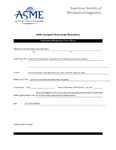Mostrar o rexistro simple do ítem
Assessment of Linearization Approaches for Multibodydynamics Formulations
| dc.contributor.author | González Varela, Francisco Javier | |
| dc.contributor.author | Masarati, Pierangelo | |
| dc.contributor.author | Cuadrado, Javier | |
| dc.contributor.author | Naya, Miguel A. | |
| dc.date.accessioned | 2021-05-31T15:07:29Z | |
| dc.date.available | 2021-05-31T15:07:29Z | |
| dc.date.issued | 2017-07 | |
| dc.identifier.citation | González, F., Masarati, P., Cuadrado, J., and Naya, M. A. (January 20, 2017). "Assessment of Linearization Approaches for Multibody Dynamics Formulations." ASME. J. Comput. Nonlinear Dynam. July 2017; 12(4): 041009. https://doi.org/10.1115/1.4035410 | es_ES |
| dc.identifier.issn | 1555-1423 | |
| dc.identifier.uri | http://hdl.handle.net/2183/28043 | |
| dc.description | This is a post-peer-review, pre-copyedit version of an article published in Journal of Computational and Nonlinear Dynamics. The final authenticated version is available online at: https://doi.org/10.1115/1.4035410 | |
| dc.description.abstract | [Abstract] Formulating the dynamics equations of a mechanical system following a multibody dynamics approach often leads to a set of highly nonlinear Differential Algebraic Equations (DAEs). While this form of the equations of motion is suitable for a wide range of practical applications, in some cases it is necessary to have access to the linearized system dynamics. This is the case when stability and modal analyses are to be carried out; the definition of plant and system models for certain control algorithms and state estimators also requires a linear expression of the dynamics. A number of methods for the linearization of multibody dynamics can be found in the literature. They differ in both the approach that they follow to handle the equations of motion and the way in which they deliver their results, which in turn are determined by the selection of the generalized coordinates used to describe the mechanical system. This selection is closely related to the way in which the kinematic constraints of the system are treated. Three major approaches can be distinguished and used to categorize most of the linearization methods published so far. In this work, we demonstrate the properties of each approach in the linearization of systems in static equilibrium, illustrating them with the study of two representative examples. | es_ES |
| dc.language.iso | eng | es_ES |
| dc.relation | info:eu-repo/grantAgreement/MINECO//JCI-2012-12376/ES/ | |
| dc.relation.uri | https://doi.org/10.1115/1.4035410 | es_ES |
| dc.rights | Atribución 4.0 Internacional (CC BY 4.0) | |
| dc.rights.uri | https://creativecommons.org/licenses/by/4.0/ | * |
| dc.subject | Multibody system dynamics | es_ES |
| dc.subject | Linearization | es_ES |
| dc.subject | Dynamics formulations | es_ES |
| dc.title | Assessment of Linearization Approaches for Multibodydynamics Formulations | es_ES |
| dc.type | info:eu-repo/semantics/article | es_ES |
| dc.rights.access | info:eu-repo/semantics/openAccess | es_ES |
| UDC.journalTitle | Journal of Computational and Nonlinear Dynamics | es_ES |
| UDC.volume | 12 | es_ES |
| UDC.issue | 1 | es_ES |
| UDC.startPage | 041009-1 | es_ES |
| UDC.endPage | 041009-7 | es_ES |
Ficheiros no ítem
Este ítem aparece na(s) seguinte(s) colección(s)
-
LIM - Artigos [43]






